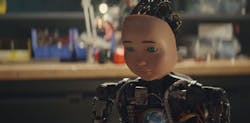Why the Creepy ‘RoboChild’ Ad Matters for AI Adoption
Does life imitate Super Bowl commercials? If so, society may be headed for a collision course as artificial intelligence enables new types of perplexing interactions with humans.
There was the ad depicting the “RoboChild” humanoid robot from TurboTax that perplexingly awoke its creator at 3 a.m. to report that it was hungry. “Wakey, wakey, papa,” it beamed in a slightly mechanical child’s voice. The robot later shared that it was in the mood for “a kale salad with chicken and guac.”
A Pringles commercial also featured a depressive AI angle. In the ad, two men sitting in a room ask hypothetically how many flavor combinations, or “stacks” of Pringles chips there were when a smart speaker answers “318,000.” The voice then added, melodramatically: “Sadly, I’ll never know the joy of tasting any, for I have no hands to stack with, no mouth to taste with, no soul to feel with.”
While all three commercials are undeniably quirky, they underscore the truth that AI adoption is moving faster than society’s ability to react to it. The mere possibility of the boyish humanoid robot RoboChild prompted legions of Twitter users to remark that the concept was “terrifying” or “creepy.”
The public’s distaste for artificial intelligence that can mimic human behavior will almost certainly continue to remain a pertinent theme as the lines between the Internet of Things and artificial intelligence continue to blur. The fact that IoT systems are capable of sensing, actuation and data processing means that society is “building a world-sized robot,” as security expert Bruce Schneier wrote. “The Internet now senses, thinks, and acts.” And the falling cost of IoT devices and cloud computing will only spur further AI adoption.
While true artificial general intelligence is likely a decade or more away, the steady evolution of the technology is bound to trigger resistance from the public, whether in the form of disgust as in the case of Twitter users venting about RoboChild or violence, as a string of attacks against self-driving cars in Arizona can attest. Self-driving vans in the state have inspired people there to throw rocks at the vehicles and force them off the roads. One person slashed a Waymo vehicle’s tires as it was stopped in traffic while another aimed a gun at the human test driver in one of the vehicles. As of December, there were 21 such altercations recorded by the police.
As AI technology progresses, there’s been a recent uptick in films tackling the subject in a frequently dystopian manner. Examples include the 2018 HBO documentary “The Truth About Killer Robots” and the series “Westworld,” the Netflix series “Black Mirror,” the 2014 film “Ex Machina” and the British series “Humans.”
In any case, the strong interest in the AI subject and the emotions it elicits reflect that significant changes are underway in terms of how humans and machines interact. Perhaps the most unsettling aspect of such advances is the fact that such systems are poised to steadily continue taking over an ever-greater share of activities formerly performed by humans. But as another RoboChild ad spot points out, such systems are far from being able to believably replicate human emotion or common sense. When RoboChild’s creator asks him what he wants to do for a living, encouraging him that he “can do anything,” he later hears that he is not “emotionally complex” enough to work in his chosen profession as a human certified public accountant, he responded: “I am sad,” before beginning to giggle.
Based on the mostly negative reaction the commercial sparked and AI’s broader potential to automate more functions traditionally performed by humans, one of the biggest barriers to AI adoption could be the public. As the aforementioned TurboTax ad put it: “RoboChild, the world isn’t ready for you yet.”
Brian Buntz is content director IndustryWeek's sister publication at IoT World Today, which hosts the Internet of Things World, an event the intersection of industries and IoT innovation. Book your conference pass & save $350, get a free expo pass, or see the IoT analytics speakers at the event.
About the Author
Brian Buntz
Content Director, IoT Institute
Brian is a veteran journalist with more than ten years’ experience covering an array of technologies including the Internet of Things, 3-D printing, and cybersecurity. Before coming to Penton, he served as the editor-in-chief of UBM’s Qmed where he overhauled the brand’s news coverage and helped to dramatically grow the site’s traffic volume. He had previously held managing editor roles on the company’s medical device technology publications including European Medical Device Technology (EMDT) and Medical Device & Diagnostics Industry (MD+DI), and had served as editor-in-chief of Medical Product Manufacturing News (MPMN).
At UBM, Brian also worked closely with the company’s events group on speaker selection and direction and played an important role in cementing famed futurist Ray Kurzweil as a keynote speaker at the 2016 Medical Design & Manufacturing West event in Anaheim. An article of his was also prominently feon kurzweilai.net, a website dedicated to Kurzweil’s ideas.
Multilingual, Brian has an M.A. degree in German from the University of Oklahoma, and he is currently working on mastering French.
